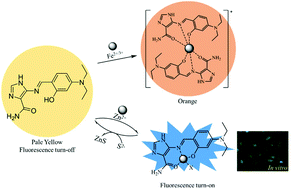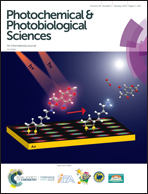A multiple target chemosensor for the sequential fluorescence detection of Zn2+ and S2− and the colorimetric detection of Fe3+/2+ in aqueous media and living cells†
Abstract
A novel multiple target sensor, (E)-5-((4-(diethylamino)-2-hydroxybenzyldene)amino)-1H-imidazole-4-carboxamide (DHIC), was synthesized for fluorescence detection of Zn2+ and S2− and colorimetric detection of Fe3+/2+ in aqueous media. DHIC can operate as a turn “on–off” sequential fluorescent sensor for Zn2+ and S2−. Detection limits (1.59 μM and 8.03 μM) for Zn2+ and S2− are below the WHO standards (76.0 μM and 14.7 μM). The DHIC–Zn2+ complex could be reversibly reused with ethylenediaminetetraacetic acid. Importantly, DHIC could image sequentially Zn2+ and S2− in living cells. Moreover, DHIC displayed a discriminatory color change from pale yellow to orange yellow to Fe3+/2+. The detection limit of DHIC for Fe3+/2+ (0.73 μM and 1.11 μM) is far below the EPA drinking water standard (5.37 μM). The sensor DHIC could be applied to analyze Fe3+ in real samples.



 Please wait while we load your content...
Please wait while we load your content...